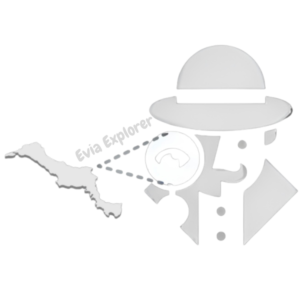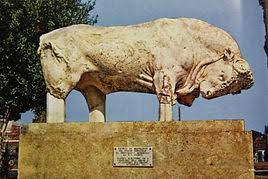Description
In August 1965 on the beach of Oreoi, during the expansion of the port, a hologlyph votive of supernatural size representing a bull came to light. The Bull of Oreoi is made of pentelic marble, representing a bull in a charging position (rushing bull-cruising bull). It is one of the largest sculptures in volume and weight that have been found in Greece, it is located on the beach of Oreoi, next to the Archaeological Collection.
The sculpture, which probably belonged to a funerary monument, dates to the end of the 4th century. e.g. and is a product of an Attic workshop and nowadays it is exhibited on a pedestal near the sea. The sculpture is made of white Pentelian marble. Its volume is close to 3m3 and weighs 4,800 kg, making it one of the largest sculptures in volume and weight that have been found in Greece. It has a length of 3.20 m and a surviving height of 1.30 m. The rear unseen side of the bull is half-serrated throughout the length of the animal and the plastic volumes are generally attributed. The legs of the bull have been broken above the knees at the thigh, apparently because they did not have the same strength as the solid rest of the body during its fall. These members were never found. At the base of the horns there is a rough circular surface with a hole in the middle, which probably indicates that they were inlaid from another material or even from a different stone.
The bull is shown with strong musculature and with a contraction of the front part of the trunk and head ¾ to the right. The animal is depicted in an attack stance (bull). The head contracts downwards and towards the main body, forming folds on the right side of the neck. The pressures received by the limbs in the back are reflected in the muscular system with intense contractions of the tumors. The surviving portion of the front right leg is presented vertically. This probably indicates a backward bending of the leg as if it were striking the ground hard and preparing to attack. The muscles of the hind limbs have contracted to such an extent, as if they were trying to contain the entire volume of the animal, which justifies this aggressive attitude. From the forward extension of the left forelimb, we assume that it was stretched so that it could balance the forces being developed.
The marbled mass on the upper part of the neck indicates a muscular and strong animal. The hair on the head seems to occupy mainly the part between the two eyes and the top of the head. The eyes are clearly carved with a prominent eyelid. On the back of the sculpture is part of the base of the tail whose middle part has been cut off, while on his right thigh is what remains of its tip. There is an iron-hell filled wormhole. The fact that the left side of the sculpture is roughly machined in contrast to its polished and detailed right and front sides proves that they were probably the only ones visible to the public.
Location
-
W3XQ+X2 Ωρεοί, Greece



Add a review